Global Transportation Infrastructure Market Research: 2031
The Transportation Infrastructure Market was valued at $1,770 billion in 2021 and is projected to reach $3,606.8 billion by 2031, registering a CAGR of 7.2% from 2022 to 2031. Transport infrastructure refers to the foundation that supports the transport system. It includes roads, railways, ports, and airports. It plays a key role in the production of transport services which, in turn, allows the market exchange of final goods and inputs. In a broader sense, transport services provide welfare benefits (e.g., travel time savings). Given its central economic role, many people often refer to transport infrastructure as the backbone of a modern economy.
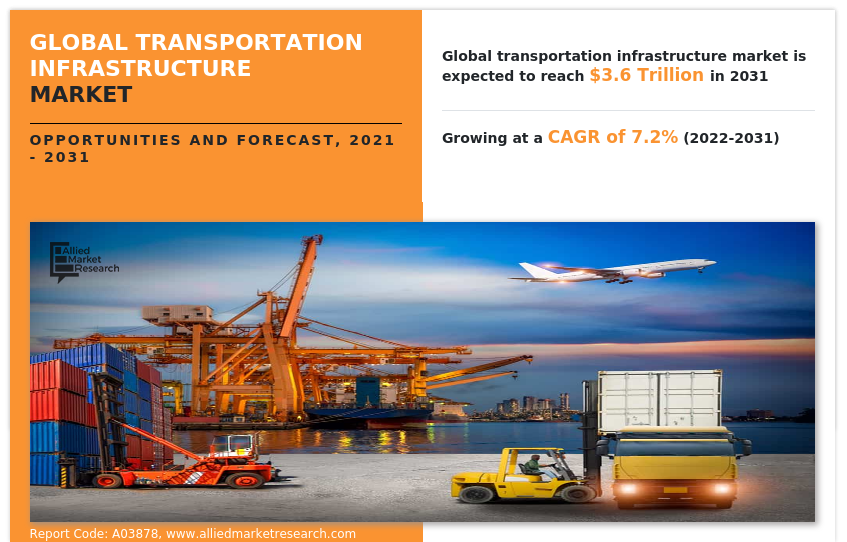
Market Dynamics
A transport system is a vital driver of social and economic development, which generates opportunities for both poor and facilitating economies to become competitive for transportation infrastructure market. Transportation infrastructure connects individuals to jobs, health services, and education on a daily basis. It facilitates the supply of goods and services globally. Transport systems facilitates the movements of different inputs like raw materials, fuels, machineries etc. for the smooth functioning of the entire production system of the country. Similarly, outputs of various sectors are carried smoothly from one place to another for bringing them into the market. Thus the transport system is providing valuable services for raising the volume of production of various sectors in different developing and developed countries benefiting the growth of transportation infrastructure industry.
Transport system has increased the mobility of labour between different regions of the country. Mobility of labour is equally important for both expansion of industry as well as for improving the lot of workers. Transport system is opening up gainful employment opportunities to unemployed and under-employed labourers of the country. The transport system helps in facilitating clear-cut geographical specialisation in respect of production. As specialisation depends on the extent of the market thus by developing markets for various products in distant areas of the country transport system facilitates specialisation.
Transport system helps in extending the size of transportation infrastructure market for various products of the countries to distant areas and removes all market imperfections smoothly and efficiently. Thus by establishing a link between production centres, distribution centres and ultimate consumers, the transport system extends the size of market for various products produced in different countries. Roads and railways are opening up various remote and inaccessible regions and makes way for tapping vast unexplored resources like minerals, forest and agricultural wealth of the countries.
The effective transport system of the country helps in creating direct demand for various industrial goods like machinery, iron and steel product etc. and thus stimulating economic development of the country. In addition, it helps in playing an important role in widening the outlook of the people of the country. It enriches social, cultural and political outlook of our people. It also removes conservative attitudes, superstition and ignorance of our people and thus widens the general outlook of the people of the country. Thus transport and communication system is playing a very important role towards economic development of the country.
The system is so important that for instance, about 20 lakh persons in India are directly employed in this transport and communication system and this sector is contributing a considerable portion of the GDP of the country. Considering its importance a sizeable portion of the plan resources of the country has continuously been allocated in successive plans for the all-round development of transport and communication system of the country. Thus, such benefits drives the growth of the market and offers lucrative transportation infrastructure market opportunity.
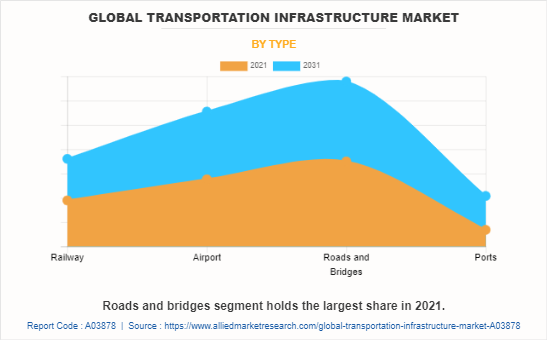
The key driver that supports the market raises the demand for transportation due to globalization. Transportation is one of the crucial sectors of any country's economy. It is involved in supporting the extensive movement of passengers and cargo within and outside its borders. Cargo transportation, such as raw materials, parts, and finished items, due to national & international trade has facilitated considerable diversity, affordability, and availability of goods in various countries. Moreover, the worldwide market is likely to get benefitted from increased government expenditures in port infrastructure to promote safe and efficient commercial activity. In addition, the growth and need for liquefied natural gas exports via marine transport is likely to contribute to a rise in demand for the industry. Furthermore, numerous sectors rely on marine shipping to import and export commodities throughout the world. Transporting products by air is more expensive than transporting commodities by water. Thus, this is likely to drive market demand even more that further help in increasing transportation infrastructure market size.
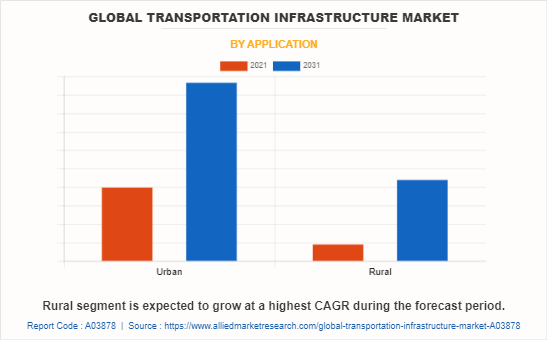
Many governments across the globe are investing in smart motorways to provide drivers with real-time information on road conditions land other traffic information. Smart highways are beneficial for hazardous and hilly areas since they provide warnings about oncoming traffic and different landslides, making driving safer. Smart roads also create energy that may be used to charge electric lighting on the side of the road and give power to moving electric vehicles. Although the population and number of automobiles on the road are expected to grow, the quantity of land accessible for road construction is limited. As a result, all countries are concerned about lack of accessible, safe, pollution-free, and congested modes of transportation. Such factors drives the transportation infrastructure market growth. Industries are developing new technologies to address them in current and future years. One of the primary driving reasons behind the highway industry is the development of several smart city initiatives in various places.
Digital sensors are used in smart transportation management systems to gather and store data in case of a landslide, severe weather, or traffic congestion, as well as display predictions and alerts on LED screens along state and national highways. For this application, major companies are developing new products. For instance, in September 2021, latest versions of Alcatel-Lucent Enterprise's OmniSwitch 6900 switching line, built for enterprise data centers and core networks have been released. As part of its Digital Age Networking (DAN) plan to simplify digital transition of corporate organizations in key vertical areas, corporations continue to expand its portfolio.
In addition, the rapidly aging transport infrastructure also drives the market globally. For instance, bridges and roads collapse due to a sharp increase in heavy vehicular traffic. The old, urban transport systems can no longer cope with the present requirements and natural catastrophes such as earthquakes and landslides that are also alding in infrastructure destruction. To address the problems & requirements, governments and investors are investing large amounts of money in infrastructure projects.
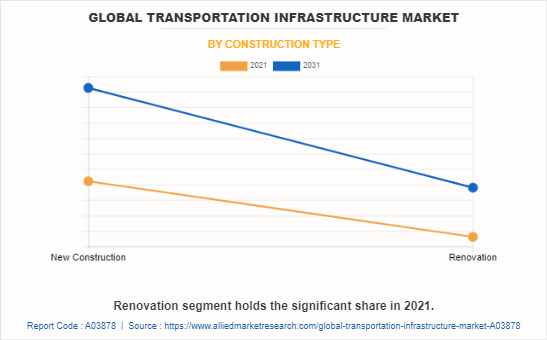
At present, the market is trying to adopt new technologies. Rapid population growth has led to growth in traffic and is creating robust demand for additional transportation infrastructure. However, many nations lack sufficient capital or space to build such roads and railways. Rapid urbanization along with the changing climate has brought about critical concerns and increased R&D to rethink new transportation systems. This has encouraged new technological improvements such as Maglev trains, intelligent transportation systems (ITS), autonomous vehicles, hyperloop, infrastructure inspection robots, and smart cars.
Global concerns such as global warming, increasing fuel prices, and shrinking resources have led to the emergence of green transport in several countries. In addition, major economies are also encouraging the adoption of green transport infrastructure such as electric vehicles (EVs), electric motorcycles, rail transport, and mass rapid transit (MRT). Hence, growing technological innovations and cross-border collaborations drive investments in various transport subsectors, especially in roads and railways. The growing demand for efficient infrastructure is expected to propel the growth of the global transportation infrastructure market.
During the outbreak of the COVID-19 pandemic, construction, manufacturing, hotel, and tourism industries were majorly affected. Manufacturing activities were halted or restricted. This led to decline in manufacturing of various equipment used for transportation infrastructure as well as their demand in the market, thereby restraining the growth of the transportation infrastructure market. Conversely, industries are gradually resuming their regular manufacturing and services. This is expected to lead to re-initiation of companies at their full-scale capacities, that helped the market to recover by end of 2021.
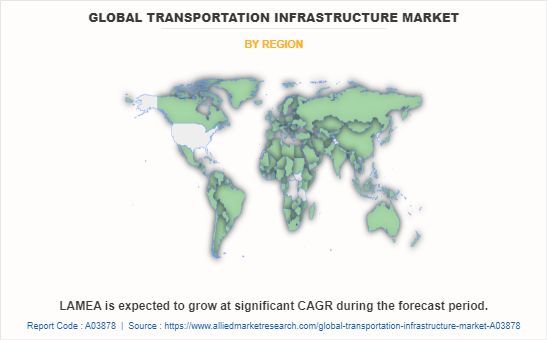
The transportation infrastructure market is segmented on the basis of type, application, construction type and region. By type, the market is fragmented into railway, airport, roads & bridges and ports. By application, the market is categorized into urban and rural. By construction type, the market is divided into new construction and renovation By region, the market is analyzed across North America (the U.S., Canada, and Mexico), Europe (Germany, the UK, France, Italy, and rest of Europe), Asia-Pacific (China, India, Japan, South Korea, and rest of Asia-Pacific), and LAMEA (Latin America, Middle East, and Africa).
In 2021, Asia-Pacific was the highest contributor to the global transportation infrastructure market share, and LAMEA is anticipated to secure a leading position during the forecast period.
On the basis of type, in 2021 the roads & bridges segment dominated the market, in terms of revenue, and the ports segment is expected to witness growth at the highest CAGR during the forecast period. As per application, in 2021, the urban segment led the market, and the rural segment is expected to exhibit highest CAGR in the near future. By construction type, the new construction segment led the market in 2021, in terms of revenue and the renovation segment is anticipated to register highest CAGR during the forecast period. Region wise, Asia-Pacific garnered the highest revenue in 2021; and LAMEA is anticipated to register highest CAGR during the transportation infrastructure market forecast period.
COMPETITION ANALYSIS
Key companies profiled in the transportation infrastructure market report include ACS Group, Balfour Beatty plc, Bechtel Corporation, Bouygues Construction SA., CK Hutchison Holdings, Globalvia Inversiones SA, kiewit Corporation, laing o'rourke, Larsen & Toubro Ltd and Vinci SA.
Major companies in the market have adopted collaboration as their key developmental strategies to offer better products and services to customers in the transportation infrastructure market.
Key Benefits For Stakeholders
- This report provides a quantitative analysis of the market segments, current trends, estimations, and dynamics during forecast period from 2021 to 2031 to identify the prevailing global transportation infrastructure market opportunities.
- The market research is offered along with information related to key drivers, restraints, and opportunities.
- Porter's five forces analysis highlights the potency of buyers and suppliers to enable stakeholders make profit-oriented business decisions and strengthen their supplier-buyer network.
- In-depth analysis of the global transportation infrastructure market segmentation assists to determine the prevailing market opportunities.
- Major countries in each region are mapped according to their revenue contribution to the global market.
- Market player positioning facilitates benchmarking and provides a clear understanding of the present position of the market players along with transportation infrastructure market analysis.
- The report includes the that includes analysis of the regional as well as global transportation infrastructure market trends, key players, market segments, application areas, and market growth strategies.
Global Transportation Infrastructure Market Report Highlights
| Aspects | Details |
| Market Size By 2031 | USD 3.6 trillion |
| Growth Rate | CAGR of 7.2% |
| Forecast period | 2021 - 2031 |
| Report Pages | 218 |
| By Type |
|
| By Application |
|
| By Construction Type |
|
| By Region |
|
| Key Market Players | Kiewit Corporation, Bouygues Construction SA., Bechtel Corporation, Larsen & Toubro Ltd, Laing O'Rourke, Globalvia Inversiones, S.A., CK Hutchison Holdings, ACS Group of Companies, LLC, Vinci SA, Balfour Beatty plc |
Analyst Review
The transportation infrastructure market witnessed a huge demand in Asia-Pacific followed by North America. The highest share of the Asia-Pacific market is attributed to increase in import and export business.
Transportation of products has become easier due to the availability of various modes of transportation such as roads, air, railway, and ports that could carry loads in higher quantity and at lower cost taking lower time.
In addition, trade barrier such as tariff, which is taxon imported goods, makes imported goods expensive. Hence, this affects import and reduces transportation and shipment. For instance, imports in the U.S. by China is higher as compared to export to China. The U.S. Government implemented tariff tax system to control imports and to save domestic businesses. Efficient trade activities promote economic growth of a country. Thus, sea ports play a crucial role in economic activities especially in the coastal areas. With increase in throughput of passengers traveling via sea and goods transport every year, the need for appropriate and improved port infrastructure has increased, which, in turn, is expected to foster the market growth. In addition, development of rail transportation is undergoing significant changes in response to the growing demand for fast transportation between and within cities and countries. Thus, such factors in turn drive the growth of the market.
Moreover, market leaders are investing millions of dollars to automate port and different transportation infrastructures by using IoT and AI systems to improve logistics and management of port. These technological advancements and infrastructural requirements are likely to create lucrative opportunities for market players.
The CXOs further added that major companies in the market have adopted acquisition, business expansion and agreement as their key developmental strategies to offer better products and services to customers.
The transportation infrastructure market size was valued at $1,770 billion in 2021 and is projected to reach $3,606.8 billion by 2031, registering a CAGR of 7.2% from 2022 to 2031.
The forecast period considered for the global transportation infrastructure market is 2022 to 2031, wherein, 2021 is the base year, 2022 is the estimated year, and 2031 is the forecast year.
The latest version of global transportation infrastructure market report can be obtained on demand from the website.
The base year considered in the global transportation infrastructure market report is 2021.
The top companies holding the market share in the global transportation infrastructure market report ACS Group, Balfour Beatty plc, Bechtel Corporation, Bouygues Construction SA., CK Hutchison Holdings, Globalvia Inversiones SA, kiewit Corporation, laing o'rourke, Larsen & Toubro Ltd and Vinci SA.
The top ten market players are selected based on two key attributes - competitive strength and market positioning.
The report contains an exclusive company profile section, where leading companies in the market are profiled. These profiles typically cover company overview, geographical presence, market dominance (in terms of revenue and volume sales), various strategies and recent developments.
By application, the urban segment is the highest share holder of transportation infrastructure market.
Loading Table Of Content...
Loading Research Methodology...


